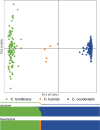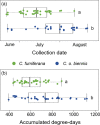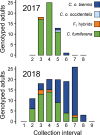Moths passing in the night: Phenological and genomic divergences within a forest pest complex
- PMID: 35126654
- PMCID: PMC8792478
- DOI: 10.1111/eva.13338
Moths passing in the night: Phenological and genomic divergences within a forest pest complex
Abstract
Temporal separation of reproductive timing can contribute to species diversification both through allochronic speciation and later reinforcement of species boundaries. Such phenological differences are an enigmatic component of evolutionary divergence between two major forest defoliator species of the spruce budworm complex: Choristoneura fumiferana and C. occidentalis. While these species interbreed freely in laboratory settings, natural hybridization rates have not been reliably quantified due to their indistinguishable morphology. To assess whether temporal isolation is contributing to reproductive isolation, we collected adult individuals throughout their expected zone of sympatry in western Canada at 10-day intervals over two successive years, assigning taxonomic identities using thousands of single nucleotide polymorphisms. We found unexpectedly broad sympatry between C. fumiferana and C. occidentalis biennis and substantial overlap of regional flight periods. However, flight period divergence was much more apparent on a location-by-location basis, highlighting the importance of considering spatial scale in these analyses. Phenological comparisons were further complicated by the biennial life cycle of C. o. biennis, the main subspecies of C. occidentalis in the region, and the occasional occurrence of the annually breeding subspecies C. o. occidentalis. Nonetheless, we demonstrate that biennialism is not a likely contributor to reproductive isolation within the species complex. Overall, interspecific F1 hybrids comprised 2.9% of sequenced individuals, confirming the genomic distinctiveness of C. fumiferana and C. occidentalis, while also showing incomplete reproductive isolation of lineages. Finally, we used F ST-based outlier and genotype-environment association analyses to identify several genomic regions under putative divergent selection. These regions were disproportionately located on the Z linkage region of C. fumiferana, and contained genes, particularly antifreeze proteins, that are likely to be associated with overwintering success and diapause. In addition to temporal isolation, we conclude that other mechanisms, including ecologically mediated selection, are contributing to evolutionary divergence within the spruce budworm species complex.
Keywords: allochrony; ecological speciation; periodicity; two‐year cycle spruce budworm.
© 2021 The Authors. Evolutionary Applications published by John Wiley & Sons Ltd.
Conflict of interest statement
We declare no conflict of interest.
Figures





References
-
- Allen, D. C. , Abrahamson, L. P. , Eggen, D. A. , Lanier, G. N. , Swier, S. R. , Kelley, R. S. , & Auger, M. (1986). Monitoring spruce budworm (Lepidoptera: Tortricidae) populations with pheromone‐baited traps. Environmental Entomology, 15(1), 152–165. 10.1093/ee/15.1.152 - DOI
LinkOut - more resources
Full Text Sources

